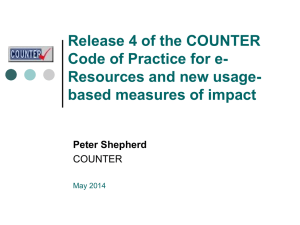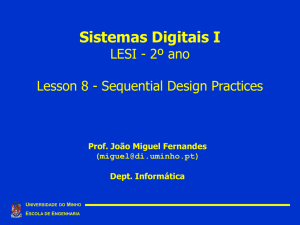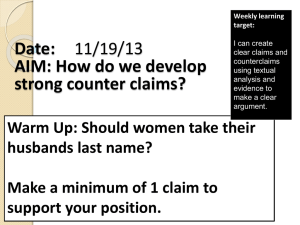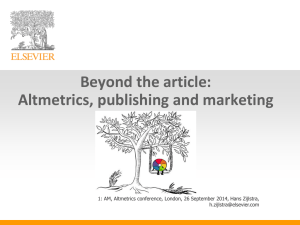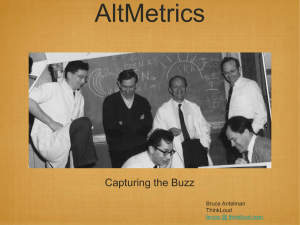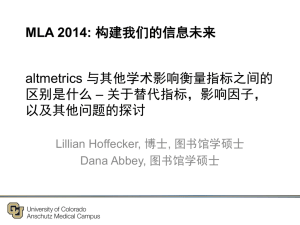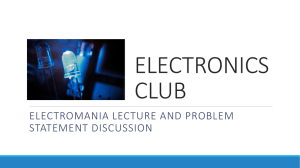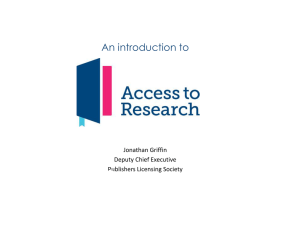SCONUL Conference
advertisement
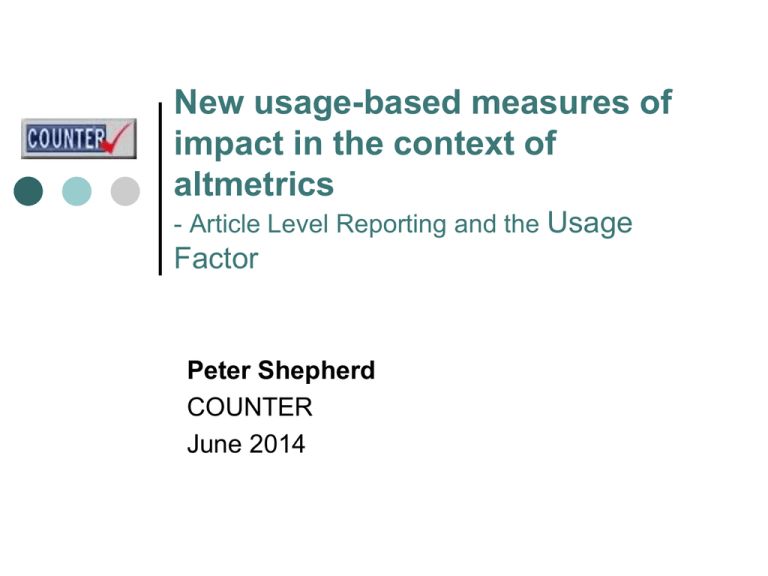
New usage-based measures of impact in the context of altmetrics - Article Level Reporting and the Usage Factor Peter Shepherd COUNTER June 2014 Altmetrics: the context ‘No-one can read everything. We rely on filters to make sense of the scholarly literature, but the narrow, traditional filters are being swamped… …the growth of new, online scholarly tools allows us to make new filters: these altmetrics reflect the broad, rapid impact of scholarship in this burgeoning ecosystem. We call for more tools and research based on altmetrics.’ From Altmetrics: a manifesto Jason Priem at al (http://altmetrics.org/manifesto/ ) Filters for the scholarly literature: Citations Peer Review Usage Altmetrics Altmetrics: what are they? Altmetrics: what are they? Based on a range of measures, including: bookmarks, links, tweets (tweeted half-life!?), Facebook, blog posts and other measures that indicate ways that readers have been influenced by a publication Reflect the fact that scholars are moving their everyday work to the web (( e.g. Mendeley, Zotero) Cover newer forms of publishing, such as datasets, blogging, ‘nanopublication’, as well as traditional articles Take into account the wider impact of research, e.g. by measuring activity in social media Reflect the ‘ongoing conversation’ around the outputs of scientific research Tend to focus on individual articles and other research outputs rather than on journals Altmetrics: pros and cons Pros, • Cover all fields of scholarship and all types of publication • Take into account activity in social media • More immediate measure of impact than citations – ‘real time’ • Scholar and item based rather than journal-based • Go beyond counting and emphasis semantic content, e.g. usernames and timestamps Cons: • What do the numbers mean? Do they reflect impact or buzz? • Less direct link to research quality • Easier to manipulate and less transparent than citation data • No widely accepted standards or benchmarks. Do 20 tweets = 1 Mendeley upload? • Can be gamed COUNTER usage-based measures in the context of altmetrics Advantages: Usage can be reported at the individual item and individual researcher level Usage is more ’immediate’ than citations Usage potentially covers all categories of online publication COUNTER usage statistics are independently audited and generally trusted Two new COUNTER Codes of Practice have been launched: COUNTER Code of Practice for Articles (COUNTER Articles) Recording, consolidation and reporting of usage at the individual article level Standard applies to publishers, aggregators and repositories COUNTER Code of Practice for Usage Factor Usage-based measure of impact of journals, institutions and individual scholars The Usage Factor for a Journal is the Median Value in a set of ordered full-text article usage data ( i.e. the number of successful full text article requests) for a specified Usage Period of articles published in a journal during a specified Publication Period. COUNTER Articles and Usage Factor are both based on the recording and consolidation of COUNTER-compliant usage data at the individual article level The new COUNTER Codes of Practice Release 4 of the COUNTER Code of Practice for eResources Release 1 of the COUNTER Code of Practice for Articles Covering journals, databases, books and multimedia databases Provides customers with usage statistics for the online products that they purchase A new COUNTER standard for recording and reporting usage ant the individual article level Release 1 of the COUNTER Code of Practice for Usage Factors A new, usage-based measure of the impact of journals and other publications COUNTER Code of Practice for Articles COUNTER Articles covers the following areas: article types to be counted; article versions to be counted; data elements to be measured; definitions of these data elements; content and format of usage reports; requirements for data collection and data processing; requirements for independent audit (under development); Release 1 of the COUNTER Code of Practice for Articles is available on the COUNTER website at: http://www.projectcounter.org/counterarticles.html COUNTER Articles: data and metadata Publisher/aggregator organizations should collect the usage data in the format specified in Article Report 1. The following data and metadata must be collected for each article: Either Print ISSN OR Online ISSN Article version, where available Article DOI Date of First Successful Request Monthly count of the number of successful full-text requests - counts must remain available for at least 24 months from Online Publication Date OR date of First Successful Request The following metadata are optional, but are desirable: Journal title Publisher name Platform name Journal DOI Article title Article type Article publication date Article types Organizations must be able to record and report usage of the following categories of journal content at the individual article level: research articles ( full articles and short communications) review articles In addition the usage reports on the following individual items are acceptable, provided they meet the data and metadata requirements listed in 4.2 above: editorials book reviews theses COUNTER Articles: article versions Only usage of the following 5 Article Versions (of the 7 versions defined by the ALPSP/NISO JAV Technical Working Group (http://www.niso.org/publications/rp/RP-8-2008.pdf)) may be counted: Accepted Manuscript (AM) Proof (P) Version of Record (VoR) Corrected Version of Record (CVoR) Enhanced Version of Record (EVoR) Usage of the following 2 Article Versions must not be counted: Author’s Original (AO) Submitted Manuscript Under Review (SMUR) COUNTER Articles – 3 Article Reports Article Report 1: publisher specification for data collection by article Article Report 2: number of successful full-text article requests by author, month and DOI, consolidated from different sources To be used by publishers for the collection of data and metadata To be used by publishers to report individual article usage to authors, broken down by source of usage Article Report 3: summary of all successful full-text article requests for an author, by month To be used by publishers to provide a summary to authors of usage for all their articles Article Report 1: specification for data collection by article Article Report 2: number of successful fulltext article requests, by Author, Month and DOI, consolidated from different sources Article Report 3: summary of all successful individual full-text article requests for an author, by month Usage Factor: aims and outcomes The overall aim of the Usage Factor project was to explore how online journal usage statistics might form the basis of a new measure of journal impact and quality, the Usage Factor for journals. Specific objectives were to answer the following questions: Will Usage Factor be a statistically meaningful measure? Will Usage Factor be accepted by researchers, publishers, librarians and research institutions? Will Usage Factor be statistically credible and robust? Is there an organizational and economic model for its implementation that would cost-effective and be acceptable to the major stakeholder groups. Following extensive testing using usage data for over 200 journals from a range of publishers the main outcome of the project has been the new COUNTER Code of Practice for Usage Factors. This new Code of Practice uses the article level usage data collected using the COUNTER Code of Practice for Articles as the basis for the calculation of the Usage Factor. The COUNTER Code of Practice for Usage Factors is available on the COUNTER website at: http://www.projectcounter.org/usage_factor.html Who will benefit from the Usage Factor? Four major groups will benefit from the introduction of Usage Factors: Authors, especially those in practitioner-oriented fields, where citationbased measures understate the impact of journals, as well as those in areas outside the core STM fields of pure research, where coverage of journals by citation-based measures is weak. Publishers, especially those with large numbers of journals outside of the core STM research areas, where there is no reliable, universal measure of journal impact, because citation-based measures are either inadequate or non-existent for these fields Librarians, when deciding on new journal acquisitions, have no reliable, global measures of journal impact for fields outside the core STM research fields. They would use usage-based measures to help them prioritise journals to be added to their collections. Research Funding Agencies, who are seeking a wider range of credible, consistent quantitative measures of the value and impact of the outputs of the research that they fund. Usage Factor metric: recommendations Usage Factors should be calculated using the median rather than the arithmetic mean A range of Usage Factors should ideally be published for each journal: a comprehensive UF ( all items, all countable versions) plus supplementary factors for selected items Usage Factors should be published as integers with no decimal places Usage Factors should be published with appropriate confidence levels around the average to guide their interpretation The Usage Factor should be calculated initially on the basis of a maximum usage time window of 24 months. The Usage Factor is not directly comparable across subject groups and should therefore be published and interpreted only within appropriate subject groupings. The Usage Factor should be calculated using a publication window of 2 years Usage Factor: Journals - the calculation Publishers will be able to generate Usage Factors using the Code of Practice, but will have to be independently audited for their Usage Factors to be listed in the Usage Factor Central Registry. Two categories of Usage Factor may be calculated The 24 month Journal Usage Factor 2010/2011: all content The median number of successful requests during 2010/2011 to content published in the journal in 2010/2011 The Journal Usage Factor 2010/2011: full-text articles only The median number of successful requests during 2010/2011 to full-text articles published in the journal in 2010/2011 Note: 1.The article-level data collected in COUNTER Article Report 1 will be used as the basis for the Usage Factor calculation 2. Usage Factors will be reported annually, for 2010/2011, 2011/2012, etc. COUNTER Articles and Usage Factor - implementation Step 1: implement COUNTER Code of Practice for Articles Step 2: Collect article-level usage data for 2014/2015 Step 3: Calculate and report Usage Factors using protocols specified in Code of Practice for Usage Factors Usage Factors Journals Report Usage Factor issues Independent audit Consolidation of usage data from different sources to provide a global Usage Factor Audit process will be based on the COUNTER and COUNTER Articles audits and will be carried out at the same time as these audits Publisher, aggregator, repositories Different approaches being investigated Central Registry Official source of audited Usage Factors Maintained by COUNTER COUNTER Articles and Usage Factor Common threads Article-based metrics • Can be rolled up to researcher, institutions and journal level Reliable, audited data • Based on tested COUNTER standards Common process/ infrastructure requirements • Similar metadata • Efficient, cost-effective processes For further information: http://www.projectcounter.org/index.html
